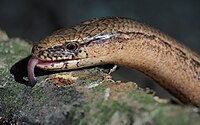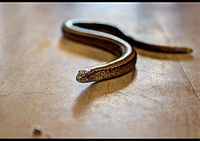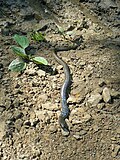Common slow worm
| Common slow worm | |
|---|---|
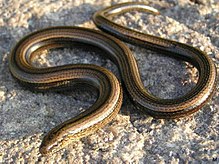
| |
| Scientific classification | |
| Domain: | Eukaryota |
| Kingdom: | Animalia |
| Phylum: | Chordata |
| Class: | Reptilia |
| Order: | Squamata |
| Family: | Anguidae |
| Genus: | Anguis |
| Species: | A. fragilis
|
| Binomial name | |
| Anguis fragilis | |
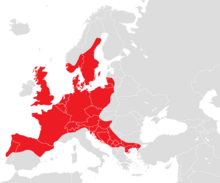
| |
| Range of A. fragilis | |
The common slow-worm (Anguis fragilis) is a species of legless lizard native to western Eurasia. It is also called a deaf adder, blindworm, or regionally, a long-cripple, steelworm, and hazelworm. The "blind" in blind-worm refers to the lizard's small eyes, similar to a blindsnake (although the slow-worm's eyes are functional). The common slow worm, i.e. the species Anguis fragilis, is often called simply "slow-worm", though the entire species complex Anguis is also called "slow-worms".
Common slow worms are semifossorial[2] (burrowing) lizards, spending much of their time hiding underneath objects. The skin of slow worms is smooth with scales that do not overlap one another. Like many other lizards, they autotomize, meaning that they have the ability to shed their tails to escape predators. While the tail regrows, it does not reach its original length. In the UK, they are common in gardens and allotments, and can be encouraged to enter and help remove pest insects by placing black plastic or providing places to shelter such as piles of logs, corrugated iron sheets or under tiles.[3] On warm days, one or more slow worms can often be found underneath these heat collectors.
The name "slowworm" is only contaminated by the word "slow". In Middle English, it was written "slowurm", from Old English "slāwyrm", where slā- means 'earthworm' or 'slowworm' and wyrm means "serpent, reptile".[4][5] It is related to the Norwegian slo or Swedish ormslå, of same meaning.
Taxonomy
[edit]
Anguis fragilis was traditionally divided into two subspecies (A. f. fragilis and A. f. colchica), but they are now classified as separate species:[6][7]
- Anguis fragilis sensu stricto (found in western Europe, northern Europe and western Balkans) and
- Anguis colchica (found in eastern and northern Europe, eastern Balkans and in western Asia).
Three more species were later distinguished from A. fragilis:
- Anguis graeca (found in southern Balkans) and
- Anguis veronensis (found on the Apennine Peninsula).
- Anguis cephalonica (native to the Peloponnese Peninsula)
Physical traits
[edit]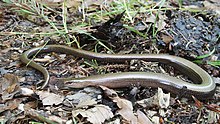
Slow worms have an elongated body with a circular cross-section without limbs and reach a maximum length of up to 57.5 cm.[8] Most adult animals are between 40 and 45 cm long, with up to 22 cm on the head and trunk section and the rest on the tail.[9] There is no visible neck. The tail, which ends in a horny tip, is continuous with the trunk and is often slightly longer. Slow worms exhibit caudal autotomy, the severing of the tail when it is pulled by predators.[10] When regrown, the tail grows back only to a short stub, probably because loss of the tail does not sufficiently affect the species' locomotion, foraging and defence abilities to necessitate full and rapid regeneration.[11]
The skin surface consists of smooth, round-to-hexagonal scales which do not overlap over one another and are roughly the same shape on the dorsal and ventral surfaces of the body. There are several longitudinal rows running along the underside. In total, the trunk has 125 to 150 transverse scale rows and the tail has another 130 to 160 rows. Under the scales there are bony plates (osteoderms), so that slow worms crawl much more stiffly and clumsily than snakes. The scaling of the head is similar to that of snakes. The ear openings are mostly completely hidden under the scales. The relatively small eyes have movable, closable eyelids (these are fused in snakes) and round pupils. The rather short tongue is broad, bilobed and does not end in fine tips. To lick, i.e. to absorb odorous substances, slow worms have to open their mouths slightly, as they lack the gap in the upper lip that snakes possess. The pointed, sometimes loosely fixed teeth are curved backwards; there are 7 to 9 teeth in the premaxilla, 10 to 12 in the maxilla and 14 to 16 in the lower jaw.[12]
Size and longevity
[edit]Adult slow worms grow to be about 50 cm (20") long, and are known for their exceptionally long lives; the slow worm may be the longest-living lizard, living about 30 years in the wild and up to at least 54 years in captivity (this record is held by a male slow worm that lived at the Copenhagen Zoo from 1892 until 1946, the age when first obtained is unknown).[13][14] The female often has a stripe along the spine and dark sides, while the male may have blue spots dorsally. Juveniles of both sexes are gold with dark brown bellies and sides with a dark stripe along the spine.
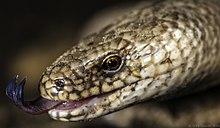
Reproduction
[edit]
In Central Europe, the mating season of the species is usually between late April and June. The males often wrestle violently around the females, although they are in the majority in most populations. The opponents try to push each other to the ground, bite each other and wrap themselves tightly around each other. When mating, the female is bitten in the head or neck region, while the male introduces his two hemipenes into the female's cloaca. Copulation can take several hours.

Sometimes, females mate with other males later. The gestation period of the females lasts 11 to 14 weeks, and subsequently, between mid-July and the end of August, and sometimes even later, they usually give birth to between eight and twelve young (extreme values: 2 to 28). Slow worms are ovoviviparous; at birth, the 7 to 10 cm long young animals are in a very thin, transparent egg shell, which they pierce immediately afterwards. They initially weigh less than a gram and still have a remnant of the yolk.[15] Juvenile slow worms have a contrasting color scheme and pattern. The top of the body is silvery-white to golden yellow, while the sides and underside are black.
Predators
[edit]Predators of A. fragilis include adders, badgers, birds of prey, crows, domestic cats, foxes, hedgehogs, pheasants and smooth snakes.[16][17][18][19] Slow worms detect the presence of predators with their tongues by flicking them in and out to 'smell'.[20]
Ecology
[edit]These reptiles are largely nocturnal and do not bask in the sun like other reptiles, but choose to warm themselves indirectly underneath objects, such as rocks, which have been warmed by the sun. They can often be found in long grass and other damp environments[21] In a 2009 study of a Danish population, the diet of the slow-worm was found to include slugs, snails, earthworms, caterpillars and pill millipedes.[22]
Protected status in the UK
[edit]In the United Kingdom, the slow worm has been granted protected status, alongside all other native British reptile species. The slow worm population has been decreasing, and under the Wildlife and Countryside Act 1981, to intentionally kill, injure, sell, or advertise to sell them is illegal.[23][24][25]
Ireland
[edit]The slow worm is assumed to be non-native in Ireland, possibly arriving in the 1900s. Due to their secretive habits they are difficult to observe and are sighted only in parts of County Clare and possibly County Galway, mainly in the Burren region.[26][27][28]
Evolutionary history
[edit]Members of the genus Anguis, to which the slow worm belongs, first appeared in Europe during the Mammal Paleogene zone 14, between 43.5 and 41.2 million years ago, corresponding to the Lutetian stage of the Eocene.[29] Remains assigned to the Anguis fragilis species complex are known from the late Miocene onwards.[30]
Gallery
[edit]-
A slow worm
-
A slow worm close
-
Slow worm in turquoise color
-
A slow worm moving through grass. This individual is a juvenile, as evinced by its golden colouration.
-
A slow worm seeks protection.
See also
[edit]References
[edit]- ^ Agasyan, A.; Avci, A.; Tuniyev, B.; et al. (2021). "Anguis fragilis". IUCN Red List of Threatened Species. 2021: e.T47113126A744263. doi:10.2305/IUCN.UK.2021-2.RLTS.T47113126A744263.en. Retrieved 9 June 2022.
- ^ "Feeding state and selected body temperatures in the slow worm" (PDF). Herpetological Journal. 18: 59–62. 2008. Archived from the original (PDF) on 17 June 2009. Retrieved 2009-06-03.
- ^ Vernon, Jean (24 July 2019). "How can I help garden slow worms?". Richard Jackson Garden. Retrieved 26 July 2022.
- ^ "Slowworm". The American Heritage Dictionary of the English Language. Houghton Mifflin Harcourt. 2017.)
- ^ "Anguis fragilis". The Reptile Database. Retrieved 2021-04-07.
- ^ "Živa – Přehlížená rozmanitost slepýšů (Jiří Moravec, Václav Gvoždík)". ziva.avcr.cz. Retrieved 2021-03-24.
- ^ Václav Gvozˇ dík, David Jandzik, Petros Lymberakis, Daniel Jablonski, Jirˇ í Moravec (2010). "Slow worm, Anguis fragilis (Reptilia: Anguidae) as a species complex: Geneticstructure reveals deep divergences". Molecular Phylogenetics and Evolution. 55 (2): 460–472. Bibcode:2010MolPE..55..460G. doi:10.1016/j.ympev.2010.01.007. PMID 20079858. Retrieved 1 April 2022.
{{cite journal}}: CS1 maint: multiple names: authors list (link) - ^ Wolfgang Böhme: A record-sized specimen of the western slow worm (Anguis fragilis). In: Zeitschrift für Feldherpetologie. Bd. 19, Nr. 1, 2012, ISSN 0946-7998, S. 117–118.
- ^ Dieter Glandt: Die Amphibien und Reptilien Europas. Alle Arten im Porträt. Quelle & Meyer Verlag, Wiebelsheim 2015, ISBN 978-3-494-01581-1, S. 322–327.
- ^ Bryant, Susan V.; Bellairs, A. d'A. (1967). "Tail regeneration in the lizards Anguis fragilis and Lacerta dugesii" (PDF). Zoological Journal of the Linnean Society of London. 46 (310): 297–305. doi:10.1111/j.1096-3642.1967.tb00510.x.
- ^ Barr, J. I.; Boisvert, C. A.; Bateman, P. W. (2021). "At what cost? Trade-offs and influences on energetic investment in tail regeneration in lizards following autotomy". Journal of Developmental Biology. 9 (4): 53. doi:10.3390/jdb9040053. PMC 8709428. PMID 34940500.
- ^ Rainer Günther, Wolfgang Völkl: Blindschleiche – Anguis fragilis Linnaeus, 1758. In: Rainer Günther (Hrsg.): Die Amphibien und Reptilien Deutschlands. Gustav Fischer, Jena u. a. 1996, ISBN 3-437-35016-1, S. 617–631.
- ^ Smith, Malcolm (1951). "The British Amphibians and Reptiles". Archived from the original on 2017-09-16.
- ^ "Slow Worm".
- ^ Heribert Wolfbeck, Klemens Fritz: Blindschleiche, Anguis fragilis Linnaeus, 1758. In: Hubert Laufer, Klemens Fritz, Peter Sowig: Die Amphibien und Reptilien Baden-Württembergs. Ulmer, Stuttgart 2007, ISBN 978-3-8001-4385-6, S. 619–632.
- ^ Ornithology, British Trust for (2010-11-24). "Slow-worm". BTO - British Trust for Ornithology. Retrieved 2022-09-10.
- ^ "Slow Worm". surrey-arg.org.uk. Retrieved 2022-09-10.
- ^ "Slow-Worm". www.froglife.org. Retrieved 2022-09-10.
- ^ "Smooth snake | The Wildlife Trusts". www.wildlifetrusts.org. Retrieved 2022-09-10.
- ^ "Slow worms: Britain's most unusual lizards". www.nhm.ac.uk. Retrieved 2024-03-19.
- ^ Grace Bettayeb (16 March 2022). "Species in Focus: Slow Worm". iwt.ie. Irish Wildlife Trust. Retrieved 1 April 2022.
- ^ Pedersen, Iben Lindegaard; Jensen, Jan Kjærgaard; Toft, Søren (2009-04-01). "A method of obtaining dietary data for slow worms (Anguis fragilis) by means of non-harmful cooling and results from a Danish population". Journal of Natural History. 43 (15–16): 1011–1025. Bibcode:2009JNatH..43.1011P. doi:10.1080/00222930802702464. ISSN 0022-2933. S2CID 84703263.
- ^ "Slow worm | The Wildlife Trusts". www.wildlifetrusts.org. Retrieved 26 July 2022.
- ^ "BBC - Science & Nature - Wildfacts - Slow worm". BBC. Archived from the original on 4 May 2007. Retrieved 2007-05-16.
- ^ "Wildlife and Countryside Act 1981". Legislation.gov.uk. Retrieved 20 September 2015.
- ^ Grace Bettayeb (16 March 2022). "Species in Focus: Slow Worm". iwt.ie. Irish Wildlife Trust. Retrieved 1 April 2022.
- ^ "Archived copy" (PDF). Archived from the original (PDF) on 2014-02-03. Retrieved 2014-01-25.
{{cite web}}: CS1 maint: archived copy as title (link) - ^ Dick Warner (18 March 2013). "Slow worm makes its entrance". irishexaminer.com. Irish Examiner. Retrieved 31 March 2022.
- ^ Rage, Jean-Claude (December 2012). "Amphibians and squamates in the Eocene of Europe: what do they tell us?". Palaeobiodiversity and Palaeoenvironments. 92 (4): 445–457. Bibcode:2012PdPe...92..445R. doi:10.1007/s12549-012-0087-3. ISSN 1867-1594. S2CID 128651937.
- ^ Villa, Andrea; Delfino, Massimo (November 2019). "Fossil lizards and worm lizards (Reptilia, Squamata) from the Neogene and Quaternary of Europe: an overview". Swiss Journal of Palaeontology. 138 (2): 177–211. Bibcode:2019SwJP..138..177V. doi:10.1007/s13358-018-0172-y. ISSN 1664-2384.
External links
[edit] Media related to Anguis fragilis at Wikimedia Commons
Media related to Anguis fragilis at Wikimedia Commons


